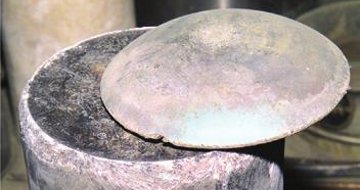
Plutonium
Plutonium General
| Name:Plutonium | Symbol:Pu |
| Type:Rare Earth, Actinides | Atomic weight:244 |
| Density @ 293 K:19.8 g/cm3 | Atomic volume:12.32 cm3/mol |
|
Discovered:
The plutonium isotope 238Pu was first produced in 1940 by Glenn Seaborg, Edwin McMillan, Joseph Kennedy, and Arthur Wahl by deuteron bombardment of the uranium isotope 238U. The metal was later found naturally in minute quantities in uranium ores. It is named after the planet Pluto. |
|
Plutonium States
| State (s, l, g): solid | |
| Melting point:912.5 K (639.4 °C) | Boiling point:3503 K (3230 °C) |
Plutonium Energies
| Specific heat capacity: 0.13 J g-1 K-1 | Heat of atomization:352 kJ mol-1 |
| Heat of fusion:2.840 kJ mol-1 | Heat of vaporization :44.0 kJ mol-1 |
| 1st ionization energy:585 kJ mol-1 | 2nd ionization energy: kJ mol-1 |
| 3rd ionization energy: kJ mol-1 | Electron affinity: kJ mol-1 |
Plutonium Oxidation & Electrons
| Shells:2,8,18,32,24,8,2 | Electron configuration:[Rn] 5f6 7s2 |
| Minimum oxidation number:0 | Maximum oxidation number:7 |
| Min. common oxidation no.:0 | Max. common oxidation no.:4 |
| Electronegativity (Pauling Scale):1.3 | Polarizability volume:24.5 Å3 |
Plutonium Appearance & Characteristics
| Structure:fcc: face-centered cubic | Color:silvery |
| Hardness:mohs | |
|
Harmful effects:
Radioactive and toxic. |
|
|
Characteristics:
Plutonium is a silvery radioactive metal that tarnishes in air to give a yellow oxide coating. It has six allotropic forms, which vary widely in crystal structure and density. The metal is chemically reactive, forming compounds with the halogens, carbon, nitrogen, and silicon. If held, plutonium would be warm to the touch because of the energy given off in alpha decay, and a large piece of the metal could boil water. Uses: Plutonium is used in nuclear bombs and nuclear reactors. Plutonium is also used to power artificial heart pacemakers and to power space probes. |
|
Plutonium Reactions
| Reaction with air:⇒ PuO | Reaction with 6 M HCl: |
| Reaction with 15 M HNO3: passivated | Reaction with 6 M NaOH: |
Plutonium Compounds
| Oxide(s):PuO, Pu2O3, PuO2 | Chloride(s):PuCl2, PuCl3 |
| Hydride(s):PuH2, PuH3 |
Plutonium Radius
| Atomic radius:175 pm | Ionic radius (1+ ion): pm |
| Ionic radius (2+ ion): pm | Ionic radius (3+ ion):114 pm |
| Ionic radius (2- ion): pm | Ionic radius (1- ion): pm |
Plutonium Conductivity
| Thermal conductivity:6.3 W m-1 K-1 | Electrical conductivity: 0.7 x 106 S m-1 |
Plutonium Abundance & Isotopes
| Abundance earth's crust:negligible | |
| Abundance solar system:negligible | |
| Cost, pure:$4000 per gram | |
| Cost, bulk:$4000 per gram | |
|
Source:
Plutonium is found naturally in minute quantities in uranium ores. Commercially, it is produced in large quantities in nuclear reactors from 238U. |
|
|
Isotopes:
Plutonium has 17 whose half-lives are known, with mass numbers from 227 to 248. None are stable. Its longest lived isotopes are 244Pu, with a half-life of 80.8 million years and 242Pu with a half-life of 373,300 years. |
|
Plutonium Other
|
Other:
|
|
Prev: Neptunium Next: Americium |